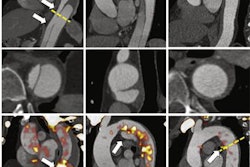
Nuclear medicine physicians showed high accuracy and consistency when reading sodium fluoride (NaF)-PET/CT scans of patients with prostate cancer metastases in a new study, published online September 3 in the Journal of Nuclear Medicine.
Danish researchers found that two experienced readers exceeded 90% agreement on the number of lesions and their location among nearly 220 prostate cancer patients. The duo also achieved near-identical results in regard to sensitivity, specificity, positive predictive value (PPV), and negative predictive value (NPV), with only a handful of relatively minor disagreements.
This consistency between readers is an important finding, since the number and location of bone metastases are "crucial to assign upfront chemotherapy or abiraterone appropriately or to offer radiotherapy in men with metastatic prostate cancer who have a low metastatic burden," wrote the study authors, led by Dr. Helle Zacho, PhD, from the Clinical Cancer Research Center at Aalborg University Hospital.
As more imaging centers switch from bone scintigraphy to PET/CT for prostate cancer, debate remains over NaF-PET/CT's efficacy for diagnosing metastases from the disease. In fact, a May study by Zacho et al concluded that the hybrid modality added little value in detecting bone metastases in patients with intermediate- and high-risk prostate cancer and normal bone scintigraphy results prior to prostatectomy.
In addition, a 2015 study by the same researchers found "excellent interobserver agreement among trained nuclear medicine physicians for the assessment of bone metastases by planar bone scintigraphy," but no such studies have been conducted using NaF-PET/CT, according to the authors.
In that case, might two heads also be better than one with NaF-PET/CT for finding prostate cancer metastases?
The researchers analyzed 219 patients (mean age, 68 years; range, 46-87 years) from four recent prospective studies in which NaF-PET/CT was performed for primary staging on 129 patients (59%), after recurrence and curative treatment for 67 patients (30%); and for metastatic castration‐resistant prostate cancer on 23 patients (11%). The two experienced board-certified nuclear medicine physicians were blinded to all clinical information except for the prostate cancer diagnosis.
The per-lesion comparison revealed the two readers agreed on both the number and location of bone metastases in 205 (94%) patients. Of the other 14 subjects, the physicians disagreed on the number of lesions in 13 patients (93%) and the location of bone metastases in one patient (7%). They also formed final diagnoses of bone metastases for 211 patients and achieved near identical results across the board.
| Diagnostic accuracy of NaF-PET/CT for bone metastases | ||||
| Sensitivity | Specificity | PPV | NPV | |
| Reader 1 | 86% | 97% | 93% | 94% |
| Reader 2 | 89% | 87% | 93% | 95% |
| Consensus | 88% | 97% | 93% | 95% |
"The high level of agreement might in part be due to their vast experience, and the experience level may render the results less generalizable for readers with less experience and for centers with low volume of NaF-PET/CT scans," Zacho and colleagues suggested.
As for the next step along the research path, they recommended that future studies explore how well NaF-PET/CT might perform in predicting patient outcomes.



















